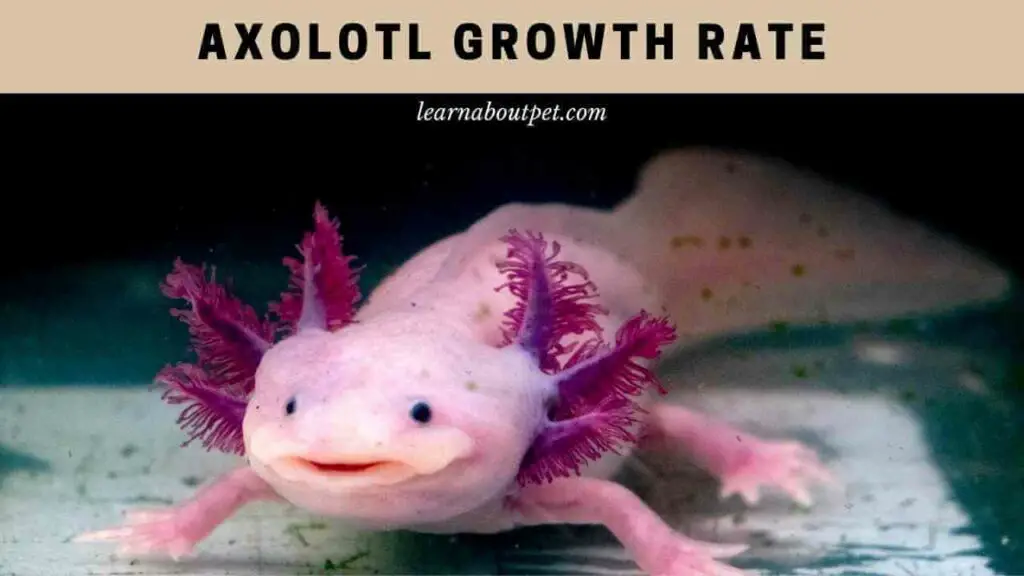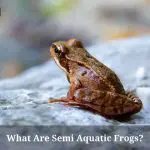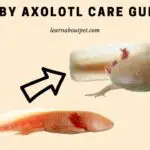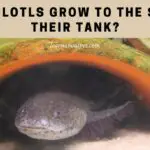Did you take care of an axolotl for the first time as your aquatic pet? Don’t worry because we will discuss the Axolotl’s growth rate. It will make it easier for you to care for axolotls to reach their life expectancy.
The average axolotl size is 9-10 inches (23-25cm). Axolotl’s full grown state when they are adults after 18 months to 2 years, and the Axolotl growth rate depends on their food and temperature tank.
I’ve personally raised axolotls to 26 cm after 6 months, and that’s fast.
Keeping axolotls healthy and providing the right environment is not difficult if you know the steps to take. If you are curious about how the axolotl growth stages, let’s see this article to the end.

How Fast Do Axolotls Grow?
Axolotls can quickly grow at their age of up to 6 months if given food that is appropriate for their age and the suitable temperature in the tank. After entering juvenile, some male axolotls are sexually mature, while female axolotls begin to sexually mature at the 12-18 months.
The axolotl growth rate will be excellent if you feed according to the schedule and provide live foods such as baby brine shrimps, daphnia, crustaceans, bloodworms, and earthworms.
It is recommended to give live foods to juveniles because axolotls are more enthusiastic about eating things that move in front of them. If their sense is sharper, you can bring dead prey or pellets instead.
Do Axolotls Grow An Inch A Month?
If juveniles are given good food, under normal circumstances they will grow one inch per month. They can also enlarge at the different axolotl growth rate, depending on other factors in the water parameters.
In the early axolotl growth stages, they must pay attention to the food given, the size of the food, and how many times they have to eat. If at the age of 8-9 months your axolotl does not reach 6-7 inches, then their growth is slow.
You can measure the length of the axolotls to ensure their normal growth. If you feel that you are giving the right food, but the axolotl doesn’t grow 1 inch in a month, you need to get references and consultations from an axolotl enthusiast for foods that accelerate axolotl growth.
How Big Is A 1 Year Old Axolotl?
You can expect axolotl size from 6-14 inches if you are one year old. The average axolotl is 9 inches at one year old, and it depends on the genetics and their nutrition.
You need to worry if the axolotl is still under 6 inches when it enters the adult stage because their body is small, and the axolotl growth rate is slow. Immediately check how much axolotl eats and whether the water parameters are appropriate.
Water parameters such as ammonia and nitrite level, the temperature at 16-18° C, tank cleanliness, water hardness, water filter, and water changes. If some of the water parameters are not met, axolotls can get stressed and refuse to eat.
How Much Do Axolotls Grow In A Month?
Axolotls have rapid growth from hatchling to juvenile. You cannot predict the rapid growth of young axolotls. But when it reaches juveniles, you can expect an axolotl to grow an inch per month if given the right food and environment.
The axolotl growth rate is seen from the water quality in the axolotl tank, and the routine owners provide food. You can give different types of food at each meal, and the axolotl can get different types of nutrients.
You don’t have to worry either that axolotls don’t grow by an average of an inch per month if they don’t show unusual behavior like floating, refusing to eat, or a swollen belly. Axolotl can slow down its growth if exposed to the disease. Ensure axolotls stay healthy so they can eat and grow normally.
When Do Axolotls Become Adult?
Axolotl becomes an adult if it is more than 6 months old. If you have a male axolotl, they are already sexually mature, although some are up to a year old before being sexually mature.
Female axolotls also become adults around one year old, and some are sexually active at that age although on average they are ready to reproduce at 18 months.
Understanding the axolotl growth stages will make it easier for you to separate the types of food needed for their development and distinguish their sex.
Before one year old, you will find it difficult to distinguish between male and female axolotls. Once sexually mature, you can clearly distinguish sex from the body shape.
Axolotl Stunted Growth
Many factors can stop the growth of axolotls. Knowing some things that can interfere with axolotl growth can be your reference so that this does not happen. The table below shows the common reasons for the axolotl stunted growth.
| Reason | Explanation |
| Water parameters | Unsuitable temperatures can slow down axolotl growth, and high ammonia levels make axolotl refusing to eat and stress. |
| Aquarium size | Aquarium that is too small can inhibit the growth of axolotl because it does not have room to move and not enough space to live. |
| Genetics | Each genetic group has a set of values for them to grow larger or smaller than the average. |
| Food | Types of food affect axolotl growth rate, such as giving the wrong diet and only giving one type of food. |
| Crowded tank | Too many little fish or tank mates stress the axolotl and refuse to eat. |
Axolotl Digestive System
Axolotls cannot tear the food they eat. The axolotl’s teeth are not designed for chewing, but only to grasp their prey. The axolotl immediately ingests live foods, and the digestive system begins to process whatever food is ingested.
You should see the size of the axolotl you have before giving the right food to the axolotl. If the food is too large, the axolotl can become constipated and interfere with the axolotl growth rate.

Feed the axolotl in small portions, and give so on until the axolotl refuses the food you give it. Immediately clean uneaten food so as not to cause ammonia in the tank. If the axolotl’s diet has been processed, they can pass stool up to a day after eating.
Axolotl Development
Studying the axolotl growth stages is not difficult if you understand to care for the axolotl in the right way at each stage. Good care makes the axolotl growth rate perfect. You can get axolotls up to 14 inches a year if you know what to do.
Axolotls are long-lived aquatic pets that can live up to 10-15 years in captivity. The axolotl development in the early stages is very fast. There are 5 stages of development, and some stages take some time. Let’s take a look at axolotl development one by one, and you know what to do.
Axolotl Egg Stage
The first stage of development is after the female axolotl lays their eggs in the tank. Fast or not hatching time from the egg state is seen from the temperature of the tank.
The female axolotl can lay up to 1000 eggs in one go. Ensure you have a tank size sufficient to incubate all the eggs. The survivability of each egg is different, it depends on how well you maintain the temperature of the tank properly.
If you set the temperature to 23°C, eggs can hatch in less than 14 days. Meanwhile, at cool temperatures ranging from 18°C-20°C, it will take at least 20 days before hatching.
The axolotl growth rate on eggs is only determined by temperature because eggs do not depend on any food. You need to keep the water in the tank clean and at a stable temperature. Frequent temperature changes drastically will also interfere with hatching eggs.
Axolotl Embryo Stage
After the axolotl hatches from the eggs, they will spawn as embryos. The embryo is 2mm in diameter with a jelly covering all around. From the embryo stage, we can see the form of the axolotl’s body from the head and body without legs.
After the embryo gets bigger, it reaches 11mm in size and enters the rapid axolotl growth state. The embryo stage can last a few days or weeks depending on genetics and other factors.
Axolotl Larva Stage
Stage larvae can be seen starting from without legs to having legs. When you enter the larva stage, you can see the axolotl’s internal organs because the skin is clear. You can keep looking at the organ until the skin goes thicker. Do not touch the axolotls at this stage as it is dangerous for them.
When the legs first appear, the front legs will grow first. Rear legs will grow last. Food is the most important thing for axolotl growth rate at this stage. Axolotls can be up to 6 months when in the larva stage.
Axolotl Young Adult
You can already see the body of the axolotl getting perfect, and they are ready to live alone in the tank. For males, axolotls are already sexually mature and ready for breeding.
Young adults have a reduced feeding time compared to young axolotls. Their sense starts to rise, and you can give them food other than live food. Do not immediately change the whole food to pellets or gel food. Give it an occasional pellet to introduce a new type of food.
The axolotl growth rate at this stage is not as fast as before. If you provide food with appropriate nutrition, the axolotl can gain an inch per month.
Fully Grown Axolotl
This is the last stage of the axolotl and will last the rest of their life. Axolotls can live independently and adapt to any food, and their lifestyle will spend more time at the bottom of the tank.
If the axolotl growth rate is always at its best, you can have a fully grown axolotl size of 18 inches or more. You need a large tank so that the axolotl can have a suitable place to live.
You need to pay close attention to axolotls during the first 6 months of their life to ensure maximum growth. Providing food according to a proper feeding schedule and meeting water parameters will make the axolotl live according to its life expectancy.
Axolotl Growth Rate Minecraft
Not only in real life, but the axolotl in the Minecraft game also has a growth rate. The axolotl will reach adulthood in 20 minutes. While still a baby, the axolotl will follow the adults.
You can speed up Minecraft axolotl growth by giving buckets of tropical fish. You can speed up axolotl growth up to 10% every time you give the bucket.
There are several ways to spawn axolotls in creative mode. Use an axolotl bucket, span egg, or summon command. You can have several types of axolotls that are distinguished by their color.
Final Verdict – Axolotl Growth Rate
Having a large and healthy axolotl is the dream of every axolotl owner. Do you want to know how to achieve good Axolotl growth rate? Axolotl can have a maximum growth rate if you can feed it properly, good and fresh food, and provide appropriate water parameters.

Water parameters include water hardness, suitable temperature, ammonia and nitrite levels, and water changes. The food given should be live foods when the axolotl is young, and pellet and gel food can be started after juvenile.
Axolotl has a rapid growth rate in the first 6 months. After that, the growth of axolotl is determined from the diet and environment. Ensure growth of axolotl to one inch per month. If it’s less than that, it could be genetics or something wrong with how to treat it.

Welcome to Learn About Pet. My name is Rajkumar Ravichandran and I love all pets, travel, and amazing food. I write about my passion and personal experience caring for multiple pets in this blog! ❤️
Post Disclaimer
DISCLAIMER: THIS BLOG OR WEBSITE, "Learn About Pet", DOES NOT PROVIDE YOU WITH MEDICAL ADVICE AND IS NOT A SUBSTITUTE FOR MEDICAL ADVICE. ALWAYS GET IN TOUCH WITH YOUR PERSONAL VETERINARIAN AND USE INFORMATION HERE AS GENERAL ADVICE.
The information, including but not limited to, text, graphics, images and other material contained on this website are for informational purposes only. No material on this site is intended to be a substitute for professional veterinary advice, food recommendation, diagnosis, or treatment. Always seek the advice of your veterinarian or other qualified health care provider with any questions you may have regarding a medical condition or for pet food related questions.







